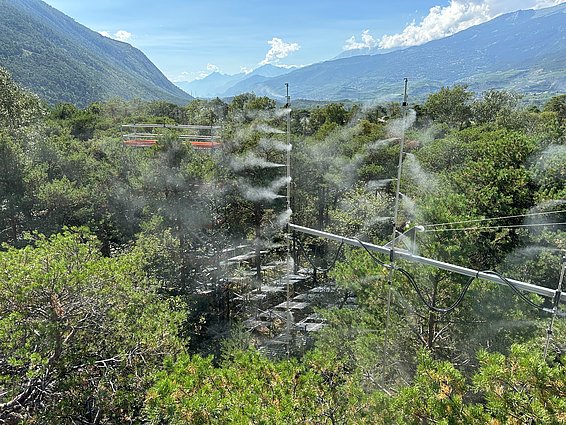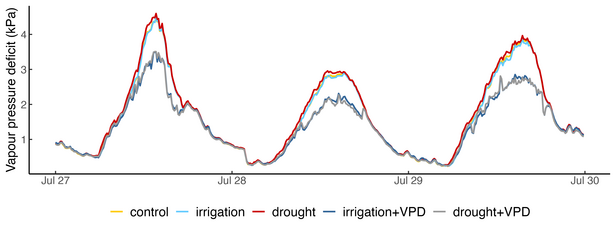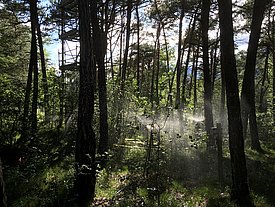28.08.2024 | Beate Kittl/Marcus Schaub | WSL News
Researchers from the Swiss Federal Institute for Forest, Snow and Landscape Research (WSL) and EPFL are spraying water mist into the crowns of mature pine trees in the Pfynwald forest in the canton of Valais. The large-scale experiment is designed to reveal the impact of soil and air drought on forest trees in the context of climate change. The experiment is presented to representatives of the media today, Wednesday.

Something peculiar has been happening in the treetops of the Pfynwald forest in the canton of Valais since early summer: numerous high-pressure nozzles mounted on tall frames are spraying water mist into the 12-metre-high treetops of mature Scots pines. The installation is part of the ‘VPDrought’ experiment, a world first that aims to unravel the effects of soil and air drought in a natural forest ecosystem.
The water mist increases the humidity – a sophisticated technique uses high-pressure nozzles to atomise water into tiny droplets that evaporate so quickly that neither the trees nor the ground get wet.
The project, which is funded by the Swiss National Science Foundation, the WSL, the EPFL and the SwissForestLab, aims to understand how hot and dry conditions affect the resilience of forests and which processes lead to the death of trees.
The climate is getting hotter and drier, as it already is in many places in the Valais. The consequences are already being felt: in the canton of Valais and in the neighbouring inner-Alpine dry valleys (the region of Innsbruck, Lower Austria, southern Styria, Vintschgau, Aosta Valley), Scots pine trees are dying and being replaced by more drought-tolerant oaks. The WSL has been studying the processes responsible for this in the Pfynwald forest for 21 years. Every night, it waters parts of this forest in order to study the trees with and without drought stress.
‘Thirsty’ air exacerbates water shortages - a vicious circle ¶
Climate change is now adding another worrying environmental factor to the mix: increasing ‘air thirst’. The warmer the air, the more moisture it can absorb. This means that the heated atmosphere extracts more water from plants and soil. This ‘thirst’ is called vapour pressure deficit (VPD).
VPD is a key factor in how much water trees evaporate through their leaves or needles, and thus has a major influence on the water supply and cooling of the plant. With rising temperatures, it is expected that the VPD will increase exponentially. High VPD values lead to excessive evaporation, which can cause plants to suffer from drought stress. In addition to the direct effects on plant physiology, a high VPD accelerates evaporation from soils, creating a vicious cycle of soil drying, land surface warming and drought stress for plants.
What is more harmful, soil or air drought? ¶
What is unusual about VPDrought is that this experiment is investigating the influence of air and soil drought in a fully grown natural forest. To this end, the approximately 130-year-old forest pines are given different amounts of soil water: either the natural rainfall of approx. 600 mm/year, twice that amount (1200 mm/year) through irrigation, or only half the natural rainfall, i.e. approx. 300 mm/year, under a rain canopy. Secondly, high-pressure nozzles are used to disperse water mist in the crowns of some of the trees during the day. This reduces the VPD – the ‘thirst’ of the air – by around 20 to 30 per cent.
The research will be conducted from the plant cell to the tree and ecosystem level. The experiment started in 2024 and will run until 2028, with results expected in the next few years.
An increasing VPD – i.e. air that is becoming increasingly ‘thirsty’ – is a challenge for both agriculture and forests. The continuous and selective measurements of over 100 parameters at the tree and ecosystem level should provide insights into how air and soil drought affects metabolic processes and the resilience of forests to drought. The findings contribute to improved climate-vegetation models and will be incorporated into future forestry strategies and the selection of future tree species.

Contact ¶
Link ¶
VPDrought: A novel approach to disentangle air dryness and soil drought
Always up to date: Subscribe to the WSL Newsletter
Copyright ¶
WSL and SLF provide image and sound material free of charge for use in the context of press contributions in connection with this media release. The transfer of this material to image, sound and/or video databases and the sale of the material by third parties are not permitted.



